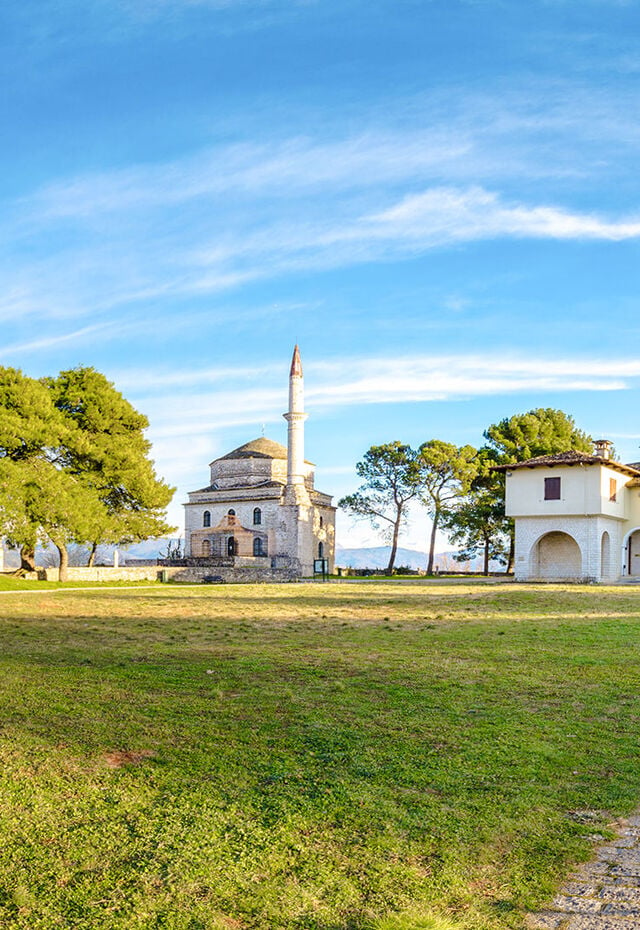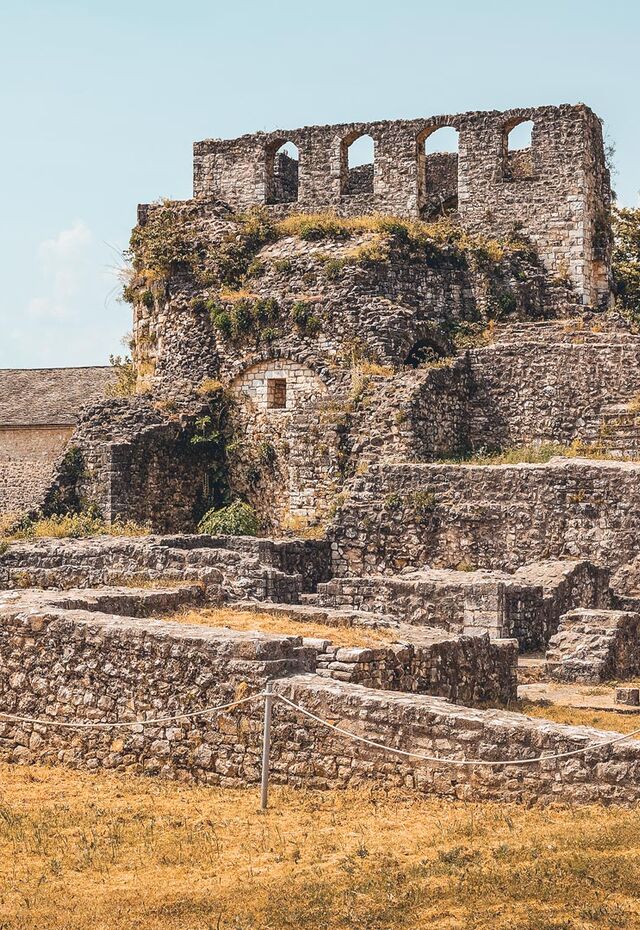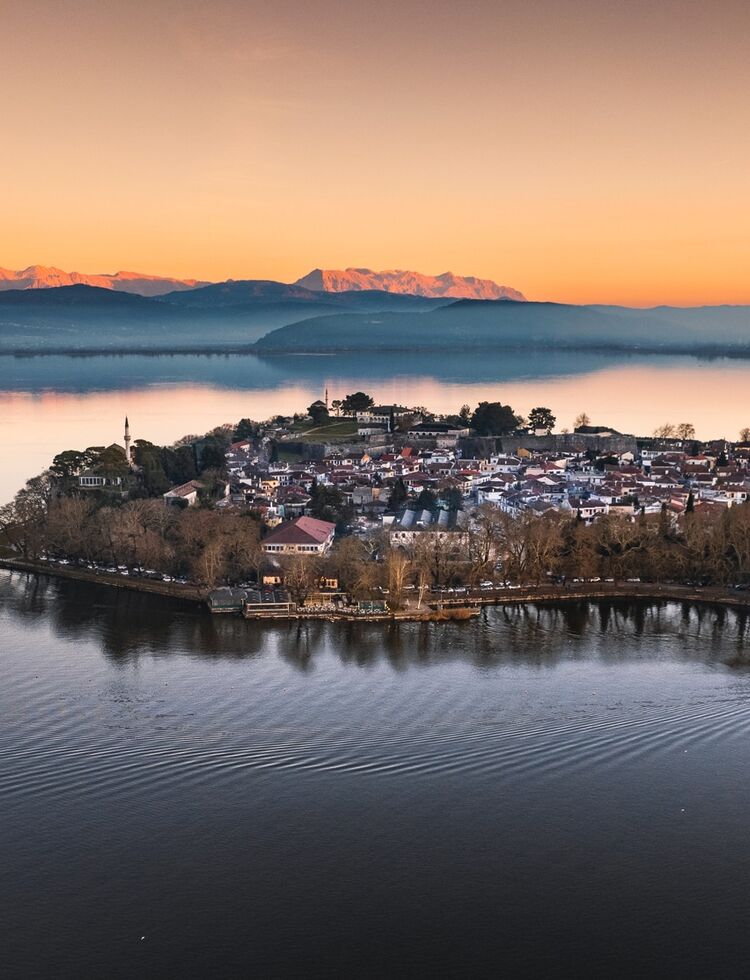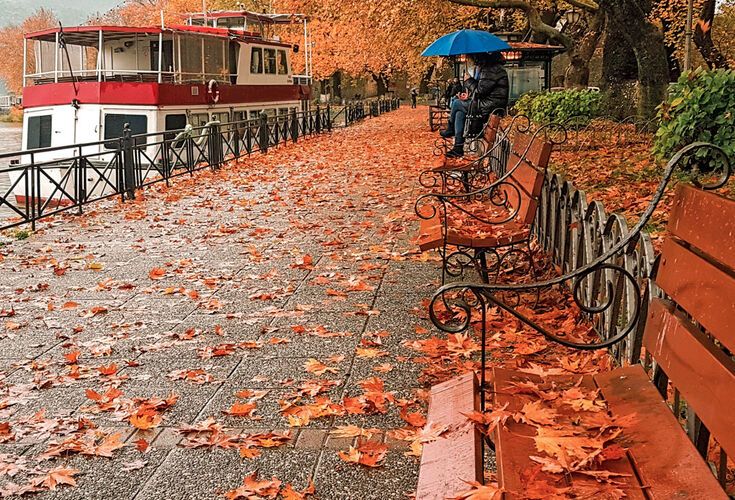

OVERVIEW
A tour of Ioannina Castle
The fortified old town of Ioannina (known as the Castle of Ioannina) has a unique history. It is the oldest continuously inhabited Byzantine castle in Greece, filled with historical buildings and museums. Records show it was developed by the Byzantine emperor Justinian I in the 6th century, although excavations have revealed Hellenistic period artefacts from the 4th-3rd century BC.
But its fame today is undoubtedly linked to the late Ottoman period and Ali Pasha, who governed over a semi-autonomous state encompassing much of Greece and Albania from Ioannina. Pasha’s rule, from 1787-1822, was both brutal and charismatic – eliminating enemies (including Ottoman Turks) and making Ioannina one of the financially and culturally richest cities in Greece.
The fortified town occupies a large rocky promontory by Lake Pamvotida (Ioannina’s famous lake) and is divided into two parts. A walled northeastern citadel was known as Epano Goulas (Upper Town) in Byzantine times when it featured a palace and church dedicated to Saint John until the Christian community was expelled and the palace was replaced by the 17th-century Aslan Pasha Mosque complex. Those are the remains we see today – although you’ll enjoy simply strolling around the labyrinth of cobbled streets with Old Town houses and cafes and shops selling souvenirs.
To the southeast is the citadel (or acropolis) known by its Ottoman name, Its Kale (Inner Fortress), which is essentially a distinct enclave within the castle (with separate walls and gates). It includes a Byzantine relic (the Tower of Bohemond) and the remains of Ali Pasha’s palace and tomb as well as a mosque and former gunpowder store and other buildings, some turned into museums.
DON'T MISS
Highlights of Ioannina Castle
Our stroll around the attractions of Ioannina Castle begins at St George’s Gate and the northeastern citadel (although neighbouring Gate B or Gate D by the lake are also options) and ends in the southeastern citadel, via the Its Kale Gate. But you can enjoy the experience in any order you like.
THE NORTHEASTERN CITADEL
The Synagogue
Turning left as you pass through St George’s Gate is a building that is neither Ottoman nor Byzantine. The Synagogue is the main surviving monument of Ioannina’s Romaniote Jew population (a community that had lived in Greece since Hellenistic times). They retained their religious identity but were fully assimilated into society and were granted the freedom to practice their religion under Ottoman rule when they lived in this quarter within the city walls. According to an inscription, the Synagogue was built in 1826, replacing an older synagogue on the same site.
Aslan Pasha Mosque & Ethnographic Museum
The Aslan Pasha Mosque was built in 1618 on the site of the Byzantine Church of Saint John, which was destroyed after an ill-fated anti-Ottoman revolt. It was part of a wider complex that included a Medrese (a college for Islamic instruction), a library and Ottoman baths and has a characteristic dome, minaret and colonnaded portico. The mosque now houses the Ethnographic Museum of Ioannina, whose collections represent the three religious communities of the city… Christian, Jewish and Muslim. A short walk away is the Soufari Sarai, a handsome two-storey cavalry school built by Ali Pasha for his troops.
ITS KALE
Ali Pasha’s Tomb
Moving through the Its Kale Gate to the Inner Fortress, you reach the northeastern complex of Ioannina Castle, most famous as the site of Ali Pasha’s palace and mausoleum. The first thing you’ll notice about the tomb is its intricate iron cage (similar in shape to a bird’s cage), providing a peaceful and atmospheric setting for the resting place of one of the most complex rulers in Greece’s history. Ali Pasha’s headless body was buried here after he was killed, aged 82, by Ottoman troops in the Monastery of St Panteleimon on the island of Lake Pamvotida. His head was paraded on a silver platter within Ioannina (and later Constantinople) to prove that he was dead. Ali Pasha’s grave was widely visited by grieving citizens of Ioannina (despite the brutality of his rule) and his tomb also contains the remains of one of his wives.
The Fethiye Mosque
Built immediately after the capture of Ioannina by the Ottomans in 1430 (its name means Mosque of the Conquest) on the site of an early 13th-century Byzantine church, the Fethiye Mosque is found next to Ali Pasha’s tomb and overlooks Lake Pamvotida. Originally a wooden structure, it was replaced by a stone building in 1611 and extensively remodelled in 1795 by Ali Pasha, who turned it into the main mosque of his palace. It is the most distinctive building of Its Kale, built at the easternmost and highest point of the citadel. The minaret in its southwestern corner is still intact, as well as its domed roof, prayer hall and open portico. Look for the decoration on the outer walls (including carvings of birds and a Muslim city) and the geometric patterns and inscriptions of the Quran within the dome.
The Byzantine Museum of Ioannina
On the other side of Ali Pasha’s Tomb is a two-storey building that replaced a military hospital constructed on the ruins of Ali Pasha’s residence after the Greeks recaptured Ioannina in 1913, now housing the city’s Byzantine Museum. The ground floor gathers sculptures, coins and ceramics as well as icons and other ecclesiastical relics from the 4th to the 19th century, with a permanent exhibition focusing on Paleo-Christian, Byzantine and Post-Byzantine artefacts, not just from Ioannina but from all over Epirus.
The Silversmithing Museum
The final stop on your tour of Ioannina Castle is one of the undoubted highlights … the Silversmithing Museum, located in the western bastion of the Its Kale fortress. Laid out over two floors of the bastion and the adjacent building of the old cookhouses, the museum charts the history of silversmithing in the pre-industrial period in Ioannina and across the region (specifically, from the 15th century onwards but with references to ancient techniques, too), focusing not just on technological advances but also the social context in which the craft developed and flourished in Epirus. As well as texts and multimedia material outlining traditional techniques of shaping and decorating silver objects, you’ll find a collection of finely crafted silver jewellery and arms, as well as household silverware and personal effects.
GET PLANNING
How do you get to Ioannina from Athens?
Ioannina has a domestic airport with flights to/from Athens a few times a week. Alternatively, you can drive from Athens along the Olympia Odos and Ionia Odos (411km, 4.5hrs) or there is a daily bus schedule from Athens to Ioannina.
How do you get to Ioannina from Thessaloniki?
There are flights from Thessaloniki to Ioannina a few times a week. Alternatively, you can drive from Thessaloniki on the Egnatia Odos (260km, 3hrs) or there is a daily bus schedule from Thessaloniki to Ioannina.
How do you get to Ioannina town from the airport?
Ioannina is 5km from the city’s airport (around 15 minutes by road). You can hire a car or take a taxi or get around by bus (check here for the bus schedule).
- There are things to do all year round in Ioannina, which is a university city.
- During the summer, you can enjoy excursions from Ioannina along the Epirus coastline to the sandy beaches around Parga and Sivota, while spring and autumn are ideal seasons for activities like rafting on the Voidomatis or Acherontas rivers or hiking in the Vikos Gorge. Meanwhile, the Zagori villages are wonderful destinations all year round.
Museums and archaeological sites in Ioannina
-
Byzantine Museum of Ioannina
Operating schedule: Open daily 8:00-20:00 (summer) and 8:30-15:30 (winter)
Contact: +30 25610 25989 & +30 25610 39580
More info for opening hours & tickets here -
Silversmithing Museum
More info for opening hours & tickets here -
Municipal Museum of Ioannina
Operating schedule: Open daily 8:00-20:00 (summer) and 8:00-15:00 (winter)
Tickets: €4.5 (€2.5 reduced)
Contact: +30 26510 26356
- Autumn
- Spring
- Summer
- Winter
- Our proposed route within Ioannina Castle, starting and ending at St George’s Gate and passing by all the highlights, is around 2.5km. So a quick tour will take around 1hr. But to really appreciate the sights and museums of Ioannina Castle, you will need to dedicate half a day.
- There is plenty to enjoy both within and outside the castle walls, including lakeside cafes.


